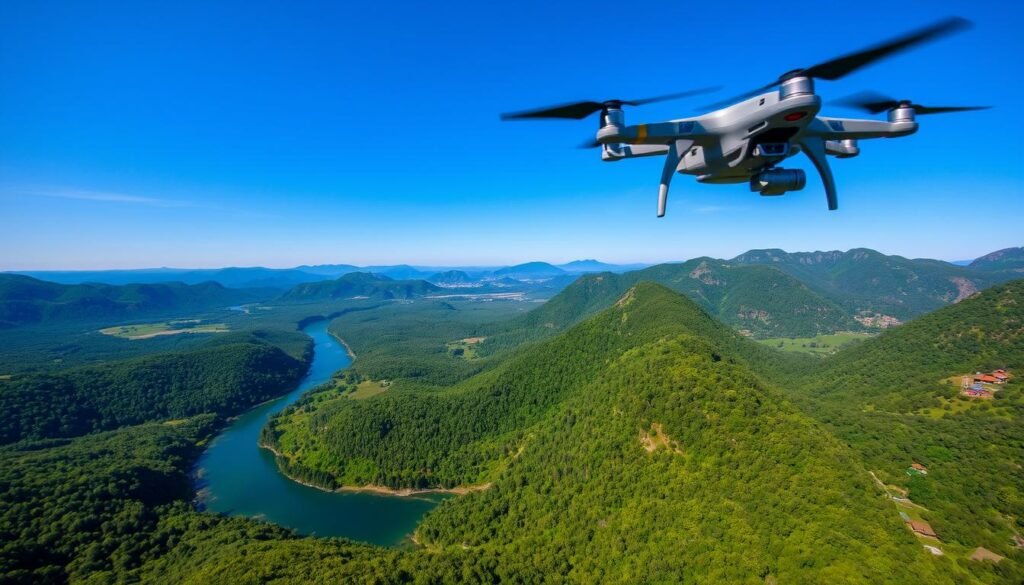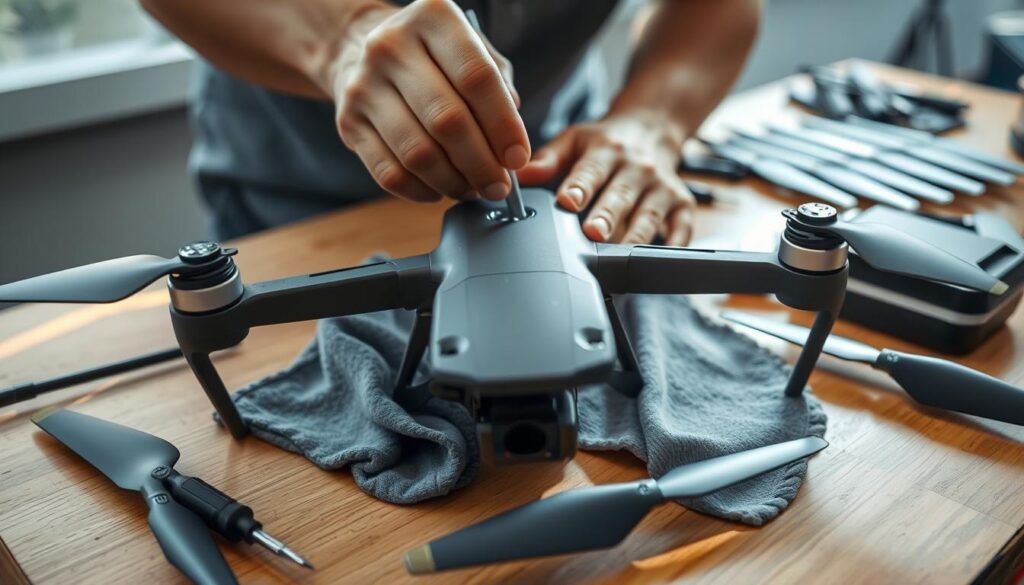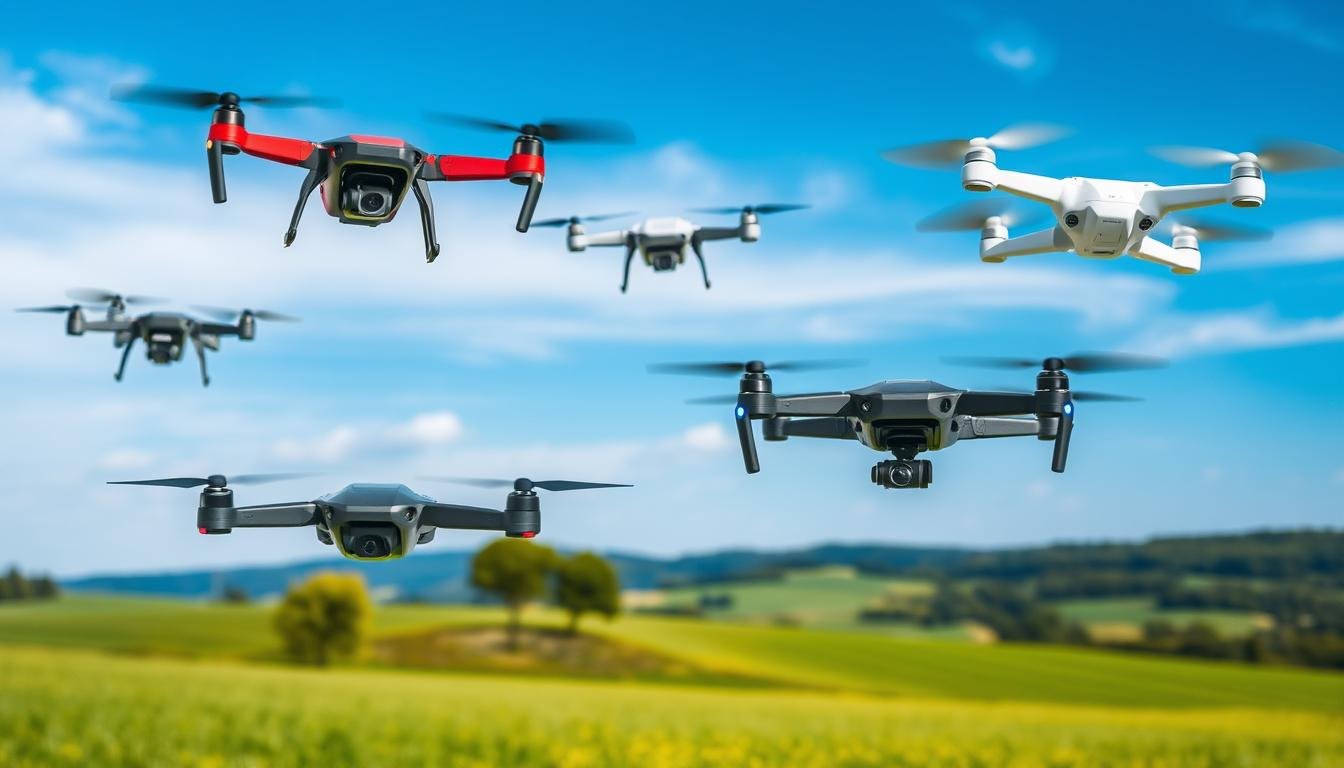“The future belongs to those who believe in the beauty of their dreams.” – Eleanor Roosevelt
The drone world is changing fast, especially for newbies. Finding the right drone can seem hard with so many choices. But, with the right help, beginners can find a great drone for their first flights. This guide will show you the best drones for beginners that are affordable but still pack a punch.
Key Takeaways
- Discover the top beginner-friendly drones under $300
- Understand the essential safety features and learning curve considerations
- Explore budget-friendly benefits and key features to look for in entry-level drones
- Dive into camera quality, flight time, and control range details
- Learn about drone flight controls, battery life, and charging essentials
Why Choose a Beginner-Friendly Drone
Starting with drones is exciting but needs careful thought. You want something safe, easy to use, and won’t cost too much. Beginner drones are perfect for newbies because they offer many benefits.
Safety Features for New Pilots
Beginner drones have cool safety features. They help you learn without worrying about accidents. Some features include:
- Stabilization systems that keep the drone steady in the air
- Obstacle avoidance sensors to prevent collisions
- Return-to-home functions that guide the drone back to its starting point
Learning Curve Considerations
Learning to fly a drone can be tough. But beginner drones are made to make it easier. They have simple controls and easy-to-use flight modes. This lets new pilots learn at their own pace.
Budget-Friendly Benefits
Getting a beginner drone is a smart move. They’re affordable without sacrificing quality. This makes drone flying accessible to more people without spending a lot.
Choosing a drone for beginners means a safe and fun start. You’ll learn to fly without spending too much.
Key Features to Look for in Entry-Level Drones
As a beginner drone pilot, picking the right drone is key. Look for features that make flying easy, stable, and fun. Here are the top things to consider when choosing your first drone.
Stability and Control Responsiveness
Stability and control are big concerns for new pilots. Choose drones with drone specifications like built-in stabilization. This keeps the drone steady, even in windy weather. Also, look for drones with controls that respond well. This lets you fly with more confidence.
Durability and Damage Resistance
Crashes happen when you’re learning. So, pick a drone that can handle bumps. Look for sturdy frames and propeller guards. These help protect your drone from damage.
Ease of Use and Beginner-Friendly Features
- Simple and intuitive control interfaces
- Automatic landing and takeoff capabilities
- Beginner flight modes with limited speed and sensitivity
- One-touch return-to-home function
Features like these make learning easier. They let you focus on flying without getting lost in complicated controls.
| Feature | Importance for Beginners |
|---|---|
| Stability and Control Responsiveness | Crucial for smooth and confident flight |
| Durability and Damage Resistance | Protects against crashes and collisions during learning |
| Ease of Use and Beginner-Friendly Features | Simplifies the learning process and boosts confidence |
Focus on these beginner drone technology features for a great start. They make your drone flying journey positive and rewarding.
“The right drone for a beginner should be easy to control, stable, and durable – it’s the key to a successful and enjoyable learning experience.”
Best Drones for Beginners: Our Top Selection
Finding the right beginner drone can be tough. We’ve picked the best drones under $300. They offer great value and performance for new pilots.
Camera Quality Comparison
The camera quality is key when choosing a drone. Here are our top picks:
- DJI Mini SE – This drone has a 12MP camera for amazing 2.7K video. It’s perfect for those who love aerial photos.
- Holy Stone HS110G – It has a 1080p HD camera and image stabilization. This drone gives clear, sharp footage for beginners.
- Potensic A20W – With a 720p camera and live video, this drone offers a unique flying experience.
Flight Time Analysis
Flight time is important for a beginner drone. Here’s what our picks offer:
- DJI Mini SE – Up to 30 minutes of flight on one charge
- Holy Stone HS110G – About 15-18 minutes of flight
- Potensic A20W – Around 10-12 minutes of flight
Control Range Details
The control range is vital for a safe and reliable connection. Here’s what our drones offer:
| Drone Model | Control Range |
|---|---|
| DJI Mini SE | 2.5 miles (4 km) |
| Holy Stone HS110G | 330 feet (100 m) |
| Potensic A20W | 328 feet (100 m) |
By looking at these factors, you can find great beginner drones. They offer a fun and easy flying experience.
Understanding Drone Flight Controls
Learning to fly a drone starts with knowing the basic flight control modes. These modes, like throttle, yaw, pitch, and roll, help pilots control their drones. They work together to give pilots the exact control they need.
The throttle lets pilots change the drone’s speed. This is how they go up, down, and stay at the same height. Yaw is for turning the drone left or right. Pitch is for moving the drone forward or backward. And roll is for tilting it from side to side.
| Control | Function |
|---|---|
| Throttle | Adjust motor speed to ascend, descend, and maintain altitude |
| Yaw | Rotate the drone left and right |
| Pitch | Tilt the drone forward and backward |
| Roll | Tilt the drone side-to-side |
It’s key for new pilots to get good at these flight control modes. This skill is crucial for flying drones for photos, videos, or just for fun. With practice, beginners can fly their drones smoothly and confidently.
“The more you practice, the more natural drone piloting will become. Take the time to familiarize yourself with the control modes and you’ll be soaring in no time.”
Battery Life and Charging Essentials
Battery life is key for drones. Drone fans need to know how long it takes to charge, look into extra batteries, and learn how to manage power. These steps help keep your drone flying without stops.
Charging Time Requirements
Charging times vary by drone model and charger. Most drones for beginners charge in 60 to 90 minutes. But, some high-end drones might need up to 2 hours. Knowing your drone’s charging time is important for planning flights.
Extra Battery Options
Getting extra drone batteries is a big plus. A spare battery lets you fly longer and avoid recharging breaks. Many drone makers sell extra batteries at good prices, doubling or tripling your flight time.
Power Management Tips
- Keep an eye on your drone’s battery level while flying and land before it’s empty.
- Steer clear of flying in strong winds or doing high-energy stunts, as they use a lot of battery.
- Use power-saving modes if your drone has them to stretch your battery life.
- Store your drone’s batteries right, as the maker suggests, to keep them lasting longer.
Knowing how to charge, getting extra batteries, and managing power well are key. These steps help drone pilots fly smoothly and enjoy their drone more. These tips are especially important for new pilots to learn for a great drone experience.
Camera Quality and Recording Capabilities
When picking a beginner-friendly drone, camera quality and recording features are key. Drone photography and aerial videography are now more popular. The image resolution of your drone’s camera greatly affects your captured images and videos.
Most beginner drones have HD cameras, ranging from 1080p to 4K resolution. Higher resolutions mean more detailed and clear footage. This lets you take amazing aerial shots and videos. Also, look for drones with image stabilization, like electronic image stabilization (EIS) or mechanical gimbal systems. These features help keep your footage smooth, even in windy conditions.
| Camera Resolution | Video Format | Frame Rate |
|---|---|---|
| 1080p | MP4 | 30fps |
| 2.7K | MP4 | 30fps |
| 4K | MP4 | 24/30fps |
When checking camera quality, also look at the video format and frame rate. Many beginner drones record in MP4 format, which works well with many devices and video editing software. Choose drones with higher frame rates, like 30 fps or 60 fps, for smoother footage.

The camera features of a drone can really impact the kind of content you can make. By knowing the important features and specs, you can pick a beginner drone that fits your needs. This will help you capture amazing aerial images and videos.
Essential Safety Guidelines and Regulations
Drone technology is growing fast. It’s key for new pilots to know the safety rules and laws for flying drones. Following these guidelines makes flying safer and helps avoid legal trouble.
FAA Registration Requirements
In the U.S., the FAA says drones over 0.55 pounds (250 grams) need to be registered. This rule helps keep flying safe and legal. Pilots must show their drone’s unique number to follow FAA rules.
No-Fly Zones
Drone fans need to know about no-fly zones. These areas include airports, military bases, and other sensitive spots. Flying here can lead to fines and legal issues. It’s important for pilots to know the local drone regulations and plan their flights wisely.
Weather Considerations
Weather affects drone safety and performance. Beginners should not fly in bad weather like heavy rain, strong winds, or thunderstorms. It’s important to check the weather forecast and consider weather considerations for safe drone operation.
By following these safety guidelines and laws, new drone pilots can enjoy their hobby safely. They keep themselves, their drones, and the environment safe.
Indoor vs Outdoor Flying Tips
Flying drones in different places can change your experience a lot. Whether you love flying indoors or outdoors, knowing the special things about each place is key. It helps you fly safely and well.
Navigating Indoor Spaces
Flying drones inside needs a gentle touch and smart moves. The small spaces, things in the way, and electronic noise can be tough for beginners. Here are some tips for flying indoors:
- Pick a drone that’s light and small for indoor use. It should have guards for the propellers and sensors to avoid things.
- Start in a big room with lots of space. This helps you get the hang of flying and doing tricks.
- Watch out for the ceiling and things like chairs and tables. They could get in the way of your drone.
- Go slow to keep better control and avoid crashes.
Embracing Outdoor Adventures
The outdoors offers a fun and big space for drone flying. But, places like parks, fields, and beaches have their own rules:
- Make sure you’re flying where it’s okay to do so. Check the local rules.
- Watch the wind. Strong winds can make it hard to control your drone.
- Look out for things like trees and power lines. They can mess up your drone’s path.
- Use the wide open to try new things and get amazing views from above.
Whether you like flying indoors or outdoors, learning about each place helps you get better. It makes you more confident and skilled at flying drones.
Maintenance and Care Guide
Proper drone maintenance and care are key for your drone’s long life and safe use. A few simple steps can keep your drone in great shape and improve its performance.
Cleaning Procedures
Cleaning your drone regularly is vital. Use a soft, lint-free cloth to wipe down the drone’s body, propellers, and other parts. Don’t use harsh chemicals or soak the drone in water, as it can harm the electronics.
Parts Replacement
Some drone parts may wear out or get damaged over time. Check your drone often for issues like worn propellers, faulty motors, or camera problems. Replace these parts quickly to keep your drone safe and working well.
Storage Guidelines
Proper storage is crucial when your drone is not in use. Store it in a cool, dry place, away from sunlight and extreme temperatures. Always remove the battery and store it separately. Consider using a protective case or cover to keep your drone safe.
By following these maintenance tips, your beginner-friendly drone will stay in top condition. It will be ready for your next adventure.

“Regular maintenance and following manufacturer instructions are essential practices for maximizing drone performance and durability.”
Common Beginner Mistakes to Avoid
Flying a drone is exciting, but it comes with its own set of challenges, especially for newbies. It’s key for beginner drone pilots to know about common mistakes. These mistakes can slow you down and even put you in danger. By knowing these issues, you can avoid them and become better at flying drones.
One big mistake beginners make is losing control of the aircraft. This can happen if you’re not used to the controls or if the weather changes suddenly. To avoid this, practice flying in open spaces. Start with simple moves and get better as you go.
Another common problem is going beyond the drone’s range or losing sight of it. It’s important to stay within the drone’s range and keep it in sight. Learn how far your drone can go and watch out for your surroundings to avoid losing it.
- Avoid flying in areas with heavy winds or bad weather because it can mess with your drone’s stability and performance.
- Make sure to properly calibrate your drone’s sensors and update the firmware to the latest version for the best results.
- Keep an eye on your battery life and plan your flights to avoid running out of power while flying.
By tackling these common mistakes and following drone pilot tips and best practices, you can improve your flying skills. This will make your drone adventures safer and more enjoyable.
Drone Photography Basics
Using a drone to take amazing aerial photos and videos is exciting for new photographers. To get the most out of your drone camera, learning the basics of aerial photography is key. This guide will cover the essential techniques for beginner drone photography.
When it comes to drone photography, composition is crucial. Flying high lets you see things from new angles. Try out bird’s-eye views, sweeping panoramas, and unique shots to make ordinary scenes look amazing.
It’s also vital to know how to adjust your drone’s camera settings. Learn to tweak the shutter speed, aperture, and ISO for clear, well-lit photos. Getting good at these drone camera techniques will help you express your creativity and take stunning aerial photography.
- Try out creative composition tricks like leading lines, symmetry, and the rule of thirds.
- Play with the camera settings (shutter speed, aperture, ISO) to get the best image quality.
- Check out different shooting modes, like burst photography and time-lapse, for cool aerial videos.
- Focus on the direction and quality of natural light to improve your aerial photography.
By learning the basics of drone camera techniques, you’ll be on your way to taking incredible aerial photography. Remember, the more you practice and stay patient, the better you’ll get at beginner drone photography.
“The best drone photos are often the result of thoughtful composition and a keen eye for detail.”
Advanced Features Worth Having
Starting your drone journey? You’ll find some beginner models have cool smart features. These include return-to-home, obstacle avoidance, and GPS. They make flying your drone more fun and safe.
Return-to-Home Function
The return-to-home (RTH) function is a game-changer. It lets your drone fly back to you if you lose control or the battery gets low. This feature keeps your drone safe and prevents it from getting lost.
Obstacle Avoidance
Obstacle avoidance is another cool feature. It uses sensors to spot nearby objects and changes the drone’s path to avoid them. It’s great for beginners as it helps prevent crashes and damage.
GPS Capabilities
Many beginner drones have GPS now. This adds precision and control to your flights. GPS drones can stay steady in the air and help with return-to-home and other automated features.
Choosing drones with these features opens up new flying possibilities. You’ll feel more confident and safe while enjoying your drone adventures.
Conclusion
As we wrap up our look at beginner drones, it’s clear there are many exciting options. Whether you like the DJI Mavic Mini, the Holy Stone HS110G, or other beginner drones, focus on safety and ease. Also, learn the basics of flying.
The drone buying guide we shared covers important points. It talks about flight controls, battery life, and aerial photography. It also mentions regulatory rules. A good entry-level UAV lets you enjoy a fun hobby and take amazing aerial photos.
The fun of flying drones isn’t just about the tech. It’s about exploring, trying new things, and flying safely. With the right drone and a focus on safety, you’ll start a new adventure. Enjoy your flights!
